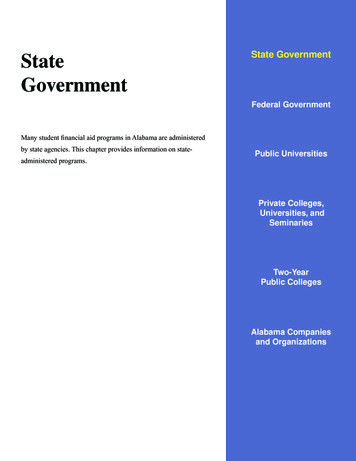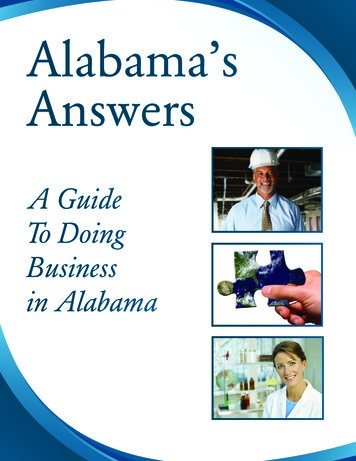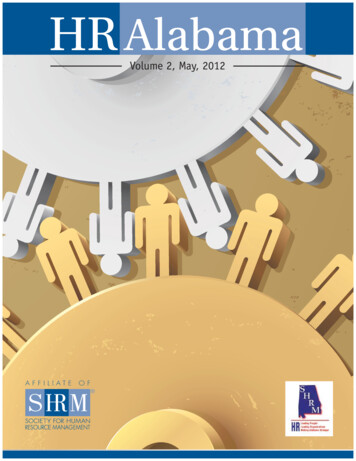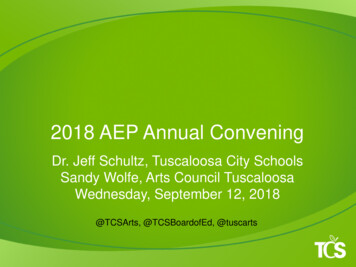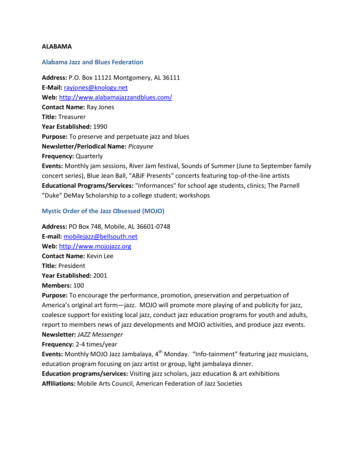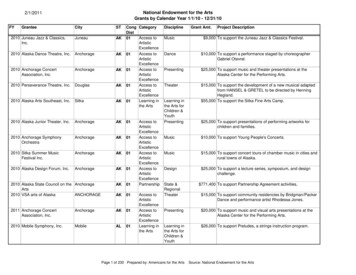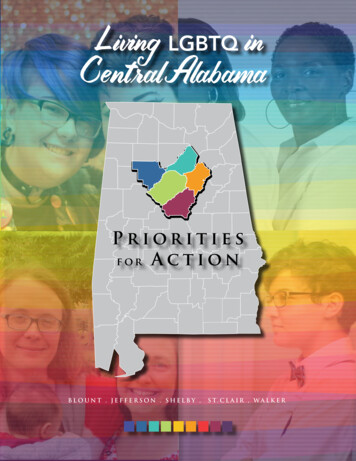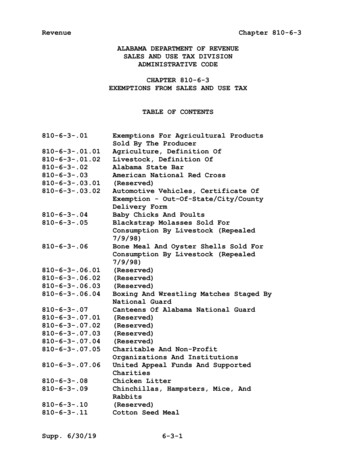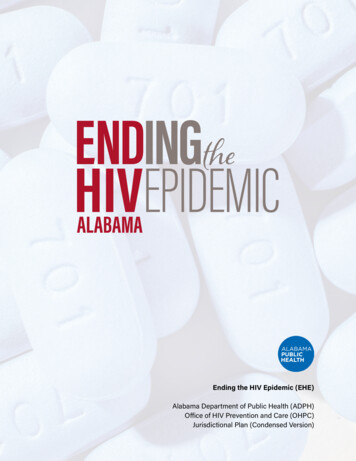
Transcription
theEnding the HIV Epidemic (EHE)Alabama Department of Public Health (ADPH)Office of HIV Prevention and Care (OHPC)Jurisdictional Plan (Condensed Version)
DEDICATIONThe Ending the HIV Epidemic Alabama Plan is dedicated to all Alabamians living and thrivingwith HIV and AIDS. This plan is also dedicated in memory of our fellow Alabamians and thoseworldwide who have lost their lives, due to the complications associated with HIV or AIDS. Intheir honor, the EHE Plan raises the bar for intentionality; individual and collective response foraction, Alabamians taking ownership to help reduce the impact of HIV and more significantly,eradicate HIV in our communities. This unified commitment is signified by the collaborative spiritof all who contributed countless hours in sharing their stories, thoughts, and experiences to bringlife to the EHE Alabama Plan. Alabama’s Plan, a living document, strives to capture the essenceof the Ending the HIV Epidemic: A Plan for America towards reaching the national 2025 and 2030goals. The time is NOW!2
CONTENTS2Dedication4Acknowledgments6Executive Summary7Introduction10Community Engagement21The HIV Epidemic in Alabama22 Epidemiology Report27 Situational Analysis37The Plan to End HIV48Measuring Progress53Appendices54 Acronyms55Letter of Concurrence56EHE Logic Model60Situational Analysis (full version)3
ACKNOWLEDGMENTSEHE Leadership TeamAdrinda Carter, MPH, Acting Director EHE Program Branch,Office of HIV Prevention and Care (OHPC), Alabama Department of Public Health (ADPH)Laurie Dill, MD, AAHIVS, Medical Advocacy and Outreach (MAO)Allison Hatchett, MPH, former Director Ryan White Part B Program Division, OHPC, ADPHScott Harris, MD, MPH, FACP, FIDSA, State Health Officer, ADPHDavid Hicks, DO, MPH, FAAFP, Deputy Health Officer, Jefferson County Health Department (JCHD)Sharon Jordan, MPH, Director OHPC, ADPHVontrese McGhee, MBA, Director Ryan White Part B Program Division, OHPC, ADPHMary McIntyre, MD, MPH, SSBB, Chief Medical Officer, ADPHMichael Mugavero, MD, MHSc, Co-Director, University of Alabama at Birmingham Center for AIDS ResearchMichael Murphree, LCSW, Chief Executive Officer, MAOJitesh Parmar, MPH, Chief Financial Officer, Thrive AlabamaJora White, MA, Director HIV Prevention Division, OHPC, ADPHEHE CommitteesAdvocacy and Legislative CommitteeBranding and Marketing CommitteeEducation CommitteeMembership CommitteeThank you to those who helped conduct the community needs assessment, facilitate the plandevelopment, organize and facilitate town hall meetings and focus groups, and the plan compilation.Office of HIV Prevention and Care, Alabama Department of Public HealthAlabama Partners for Health, Inc.Claris AdvocatesHuman Rights Campaign AlabamaMark Moore Creates LLC4
ACKNOWLEDGMENTSEHE Alabama Partner Organizations as of December 9, 2020:Would you like to become a partner?Email us at Chelsey.holland@adph.state.al.us or jonathan.joseph@adph.state.al.usJefferson County Health DepartmentLifelines Counseling ServicesMedical Advocacy OutreachMental Health Association in Morgan CountyNew Salem Christian ChurchOne Place of ShoalsRape Counselors of East Alabama, Inc.Rehab SelectResource and Advocacy CenterSafehouse of Shelby CountySelma AIRShoals Crisis CenterSouthern AIDS CoalitionTeens Empowerment Awareness with Resolution, Inc.The House of Ruth, Inc.The Knights and Orchids SocietyThe LighthouseThe University of AlabamaThe University of Alabama Medical SchoolThe University of Alabama Project HealthThrive AlabamaTurning PointTuscaloosa Diversion DepartmentTuscaloosa SAFE CenterUniversity Wellness CenterUniversity of Alabama – Birmingham (UAB)UAB 1917 ClinicVictim Services of Cullman, Inc.Whatley Health Services2nd Chance, Inc.AIDS AlabamaAIDS Alabama SouthAlabama A & M UniversityAlabama Coalition Against Domestic ViolenceAlabama Coalition Against RapeAlabama Department of Public HealthAlabama Department of Rehab ServicesAlabama Partners for Health, Inc.Alabama Regional Medical ServicesAuburn UniversityBirmingham AIDS OutreachCapital City GastroenterologyCentral Alabama AIDS Resource & AdvocacyCenter, Inc.City of MontgomeryClaris AdvocatesCrisis Center, Inc., Rape Response and SANECrisis Services of North AlabamaDumas Wesley Community CenterEast Alabama Medical CenterFamily Services of North AlabamaFamily Sunshine CenterFirst Methodist ChurchFive Horizons Health ServicesFranklin Primary Health CenterGoodWorks: North Alabama Harm ReductionHealth Services Center of AlabamaHuman Rights Campaign Alabama5
EXECUTIVESUMMARYThe Ending the HIV Epidemic Alabama Plan 2020-2030 was developed in response to a Centers forDisease Control and Prevention (CDC) initiative aimed at reducing new HIV infections by 75 percent by2025 and 90 percent by 2030. Alabama has been identified as one of the priority jurisdictions targeted forPhase I of the Ending the HIV Epidemic: A Plan for America (EHE) initiative.The Plan is the product of a collaborative process conducted through community meetings, focus groups,surveys, and provider interviews. Human immunodeficiency virus (HIV) prevention and care providers,people with HIV (PWH), and other community members participated in all data collection phases. The Planreflects the vision of a community that has struggled with the effects of stigma, lack of health education,and limited resources in the most vulnerable populations of this state. Social determinants of health weregiven special consideration in the design of the Plan so that its interventions might reach Alabama’spriority populations through community collaboration, and new and innovative prevention and careactivities.Following an overview of the HIV crisis in Alabama, the collaborating participants created an EHE AlabamaPlan composed of four main sections.1. A community needs assessment conducted March-July 2020 identified gaps in HIV prevention andcare planning relative to stigma, HIV education, lack of resources and cultural sensitivity.2. A process of community engagement.3. A timeline for implementation of specific activities across four tiers-- diagnose, prevent, treat, andrespond.4. A plan to measure progress toward objectives.Recommendations made by the participants are included in the Situational Analysis. The use of effectiveinterventions and peer-reviewed strategies ensures that populations identified as having the greatest riskfor HIV transmission and acquisition receive the necessary resources to reduce new infections.This Plan is intended to be a living document to guide future prevention and care efforts in the state. Formore information about the Plan or community engagement activities, please contact the Acting DirectorEHE Program Branch or one of the three End HIV Alabama (EHA) Co-Chairs below:Adrinda Carter, Acting Director EHE ProgramBranch, ADPH, adrinda.carter@adph.state.al.usShey Thomas-Thorn, Interim Co-Executive Director,AIDS Alabama South, shey.thorn@aidsalabama.orgCarmarion D. Anderson-Harvey, State Director,Human Rights Campaign (HRC) Alabama,carmarion.anderson@HRC.orgTony Christon-Walker, Director of Prevention andCommunity Partnerships, AIDS Alabama,tony.walker@aidsalabama.org6
INTRODUCTION7
HIV in AlabamaINTRODUCTIONThe HIV/AIDS epidemic in Alabama is of moderate magnitude compared to other states. Approximately1.1 million people in the United States are living with HIV. The CDC estimates that 14 percent of thesepeople are unaware of their infection. According to the CDC, approximately 38,000 new infections occurin the United States each year. Between 1982 and 2017, a total of 21,302 cases of HIV infection werereported to ADPH. Alabama’s HIV epidemic includes more than 15,000 PWH, with between 650 to 700newly diagnosed cases reported each year. One-quarter of newly diagnosed cases have an AIDS-definingcondition at the time of diagnosis, indicating late diagnosis in a long-standing infection. In addition tothe reported HIV burden, prevalence estimates indicate 1 in 6.5 PWH in Alabama are unaware of theirinfection, bringing the estimated number of cases to over 17,800. Alabama’s HIV Continuum of Care shows57 percent of diagnosed PWH were retained in care during 2018, meaning as many as 43 percent of PWHdid not receive continuous HIV medical care.Alabama is primarily rural: 55 out of 67 counties are located outside of the state’s major and minor urbanpopulations, and 40 counties are considered to be extremely rural. Only seven counties are in major urbancenters, and another five are located in minor urban centers. While most PWH live in more populatedcounties, rural counties that tend to be medical care deserts without adequate access to standard medicalcare or specialized HIV care, report the highest prevalence of HIV. Data trends reveal HIV infects andaffects persons of all genders, ages, races, ethnicities, and socioeconomic groups in Alabama. Certainpopulations, however, are more affected and experience the highest rates of associated health disparities.These include: Gay and bisexual men (GBM) and other men who have sex with men (MSM), especially black andLatinx GBM, within age clusters and specific characteristics and needs (youth and older GBM) Persons identifying as transgender Cisgender women, especially African American women People who inject drugs (PWID)The emergence of COVID-19 created another health burden for PWH. State-wide safety measures andcoronavirus morbidity have complicated health care access and the delivery of HIV prevention and careservices. Some organizations that provide crucial services are not yet functioning at their pre-syndemiccapacities. Housing instability, loss of income, food insecurity, isolation, and severe illness are someadditional challenges PWH have faced because of the COVID-19 pandemic.Ending the HIV Epidemic Jurisdictional Plan ApproachThe OHPC partners with AIDS Service Organizations (ASOs), community-based organizations (CBOs),non-profit organizations, government agencies, non-government public and private organizations, faithbased organizations, colleges and universities, and others across the state to implement strategies that arebased on the best available evidence across the four pillars of the EHE initiative: diagnose, treat, prevent,and respond. Alabama’s EHE Jurisdictional Plan outlines implementation of comprehensive HIV preventionand treatment strategies that complement Ryan White and other U.S. Department of Health and Human8
Services programs designed to support ending the HIV epidemic in America by leveraging powerful data,tools, and resources to reduce new HIV infections by 75 percent in five years.Stigma is an enormous barrier to fighting HIV in the Deep South. The OHPC remains vigilant in supportingand promoting best practices that help reduce stigma and increase access to prevention and care servicesand other health resources. The EHA planning group utilizes sub-committees to research and implementstate-wide strategies that promote inclusion, parity, and equity through advocacy and other capacitybuilding efforts. The goal of the Committee is to build and strengthen collaborations among traditionaland non-traditional HIV prevention and care providers, and leverage resources and expertise unique toindividual CBOs and ASOs to end the HIV epidemic.9
COMMUNITYENGAGEMENT10
“You want people to know that they will have people who are goingto be with them You want to have someone who can walk with you and learn as youlearn about yourself as you begin to make a new plan [for treatment]. That plan couldinclude transportation or housing assistance. [We] make sure that the basic needsare being met for folks before we can ask them to make a huge commitment likechanging their lifestyles. They are already in an uncomfortable position.”COMMUNITY ENGAGEMENTPurposeAccording to the CDC, “community engagement” is the process of working collaboratively with andthrough groups of people affiliated by geographic proximity, special interest, or similar situations toaddress issues affecting the well-being of those people. It is a powerful vehicle for bringing aboutenvironmental and behavioral changes that will improve the health of the community and its members.It often involves partnerships and coalitions that help mobilize resources, influence systems, changerelationships among partners, and serve as catalysts for changing policies, programs, and practices. Thecommunity engagement process is one of three steps in the CDC’s HIV Community Planning process,which includes: Stakeholder Identification;Results-oriented engagement process; andJurisdictional HIV prevention plan, development, implementation, and monitoring.11
BackgroundUpon learning of the EHE Initiative, Dr. Scott Harris, State Health Officer, formed an EHE LeadershipTeam comprised of OHPC staff and leadership from ASOs in Montgomery and Birmingham. Initially ASOsthroughout the state were asked to designate two delegates to help staff the committee. The team’splanning conversation was to ensure that the community had a voice and that strategies and activities ofthe plan were relevant to their communities.Recruitment flyers were also developed and distributed by email within the county health departments(CHDs) and to other Alabama CBOs. Prioritized populations were offered a seat at the EHE planning table.“Listening Sessions” with community stakeholders were indeed critical to the process. Sessions heldprompted ADPH to: Convene focus groups in rural areas throughout the state. Set up recruitment booths at health fairs and conferences. Gain access to college campuses and other public institutions. Establish an EPC, also known as EHA.In late March 2020, safety concerns with the COVID-19 pandemic resulted in a change in recruitmentplans. ADPH and Alabama Partners for Health, Inc. pivoted plans to work through current members’ socialand professional networks to recruit individuals to join the planning process using alternate platforms (i.e.,Zoom meetings, Facebook, YouTube, conference calls).Developing relationships and encouraging participation among community members who have a stake inand support public health involves modeling certain “practice elements” (McCloskey et al1). The goal wasto: Identify community members, key stakeholders, and resources. Develop strategies to facilitate information and ideas among community members, keystakeholders, and OHPC staff. Build and manage sustained formal and informal networks to strengthen relationships,communicate messages, and leverage resources. Empower community toward decision-making and social action.These “practice elements” were achieved by: Conducting both targeted and broad EHA recruitment. Consulting with established local advocacy groups, ASOs, and Linkage Specialists (peeradvocates). Conducting a comprehensive needs assessment that included surveying, facilitating focus groups,and interviewing local HIV care providers. Coordinating regular monthly EHA planning and sub-committee meetings.1.Principles of Community Engagement: Definitions and Organizing Concepts from the Literature. Donna Jo McCloskey, RN, Ph.D.,(Chair), Mary Anne McDonald, DrPH, MA, Jennifer Cook, MPH, Suzanne Heurtin-Roberts, Ph.D., MSW, Stephen Updegrove, MD,MPH, Dana Sampson, MS, MBA, Sheila Gutter, Ph.D., Milton (Mickey) Eder, PhD12
“Sometimes you cannot even talk to people about HIV because theythink it is something awful. Our community is not educated on this matter. Sometimespeople don’t even want to mention it. The priority needs to be the education aboutthe risk of getting HIV, life after diagnosis and everything else.This condition is not a death sentence, people need to know that.”FY2020 Community Engagement ActivitiesMarch Data collection plan for Community Needs Assessment developed.Recruitment for priority populations.Community and client surveys distributed in English.April EHA meeting via Zoom.Community and client surveys were distributed in Spanish.Focus groups were conducted with Linkage Specialists (peer mentors).Focus group conducted with Positive Living Council.May EHA meeting via Zoom.Eight provider telephone interviews were completed.Worked with an English to Spanish translator/interpreter to recruitHispanic/Latinx members, translate documents, send email, phonemembers, and interpret as necessary for monthly meetings.Focus group conducted with ASO staff throughout the state.Focus group conducted with The Knights and Orchids (TKO) Society, alesbian, gay, bisexual, transgender, queer (LGBTQ) advocacy group.Focus group conducted with Hispanic/Latinx community members. June EHA meeting via Zoom.Focus group conducted on molecular surveillance issues.Focus group conducted with housing/homeless preventionprofessionals.13
July EHA meeting via Zoom.Completed quantitative data collection.August EHA meeting via Zoom.Completed draft situational analysis from data collected through needsassessment and EHA meetings.Formed a Branding and Marketing Sub-Committee.Started a private Facebook page for the Committee to shareinformation and post updates. September EHA meeting via Zoom.Held a Situational Analysis review meeting for EHA via Zoom.Adopted a Committee logo.October EHA via Zoom.Established two additional subcommittees: Membership andAdvocacy/Legislative.Committee voted via electronic survey on date and time changes formeetings to include more community members throughout the state.EHE Jurisdictional Plan rough draft presented to Committee. 14
“The HIV positive partner will disclose and educate their partner.Partner communication is very important. When you have a partner you need to talkabout this [and tell them that we have this medication [PrEP] as an option and youcan have a fulfilling life even with this condition.”RecruitmentThe team worked through social networks to recruit PWH, treatment providers, housing professionals,educators, social workers, counselors, tribal members, faith leaders, and community volunteers. As aplanning committee, this group of diverse individuals meets monthly to share their collective wealth ofexperience through guided discussion across the four EHE pillars: diagnose, treat, prevent, and respond.Each month during data collection for the Jurisdictional Plan, discussion questions for the upcomingEHA meeting were sent out in advance to prepare members for discussion. EHA members were askedto invite other stakeholders to join meetings that might be of interest. Recruitment will continue and beenhanced by a special Membership sub-committee who will ensure that prioritized populations havecontinuous representation on the Committee. Prioritized populations in Alabama include PWH, people withtrans experience, African Americans, Latinx people, MSM, and those who have unstable housing or areexperiencing homelessness.15
Consultation and FeedbackThroughout the community engagement process, the leadership team received feedback from communitymembers that resulted in consultation with several individuals and community groups, including Latinxoutreach workers, housing professionals, and LGBTQ and HIV advocacy groups. Consultation withcommunity gatekeepers and stakeholders resulted in: English to Spanish translation of surveys, agendas, emails, and all other committee documents. Availability of a Spanish interpreter for EHE meetings. Provision of incentives for survey completion. Discussions with AIDS Alabama to assure accurate and relevant information about housing issuesfaced by PWH. Assistance with recruiting people with transgender experience from the Alabama chapter of theHRC and ADPH.Information gathered from provider interviews, focus groups, surveys, and community meetings formedthe Jurisdictional Plan. The charts below, organized by pillars, illustrate how needs assessment data andquestions posed during monthly meetings provided community input for the 10 work plan strategies.DIAGNOSISEHE StrategyCommunity Input SourceStrategy 1A. Expand or implementroutine opt-out HIV screening inhealthcare and other institutionalsettings in high prevalencecommunities.InterviewsStrategy 1B. Develop locallytailored HIV testing programs toreach persons in non-healthcaresettings.InterviewsStrategy 1C. Increase at least yearlyre-screening of persons at elevatedrisk for HIV infection per CDCtesting guidelines, in healthcare andnon-healthcare settings.Interviews16Focus groupsJuly’s EHA meetingFocus groupsJuly’s EHA special topics focusgroups included individualsidentifying as transgender andLatinx, and those experiencinghomelessnessFocus Groups
“When they [providers] find out that [I am a transgenderwoman], I just embrace the moment. I am becoming comfortable with myself and so Imake them more comfortable so that they can learn to understand. I want them to seeus as just another human being, just like them.”TREATMENTEHE StrategyCommunity Input SourceStrategy 2A. Ensure rapid linkageto HIV care and antiretroviraltherapy (ART) initiation for allpersons with newly diagnosed HIVInterviewsStrategy 2B. Support reengagement and retention in HIVcare and treatment adherence,especially for persons who are notrecipients of Ryan White HIV/AIDSProgram (RWHAP).PREVENTIONFocus groupsClient surveysAugust’s EHA special topics focusgroups included persons identifyingas transgender and Latinx, andthose that are experiencinghomelessnessEHE StrategyCommunity Input SourceStrategy 3A. Accelerate efforts toincrease Pre-exposure prophylaxis(PrEP) use, particularly forpopulations with the highest ratesof new HIV diagnoses and low PrEPuse among those with indicationsfor PrEP.InterviewsStrategy 3B. Increase availability,use, and access to and quality ofcomprehensive syringe servicesprograms (SSPs).17Focus groupsClient surveysCommunity surveysAugust’s EHA special topics focusgroups included persons identifyingas transgender and Latinx, andthose that are experiencinghomelessness
RESPONSEEHE StrategyCommunity Input SourceStrategy 4A. Develop partnerships,processes, data systems, andpolicies to facilitate robust, real-timecluster detection and response.InterviewsStrategy 4B. Investigate andintervene in networks with activetransmission.Focus groupsMay’s EHA special topicsfocus group was on molecularsurveillanceStrategy 4C. Identify and addressgaps in programs and servicesrevealed by cluster detection andresponse.Priority PopulationPersons who identify astransgenderCisgender women of colorPWIDIdentified NeedsCommunityInput SourcesHIV testingInterviewsSTD testingFocus groupsHCV testingClient surveyPartner servicesCommunity surveyHealth educationMay’s EHA special topicsfocus groups includedpersons identifying astransgender and Latinx, andthose that are experiencinghomelessnessPrevention servicesGay African American menEHA Monthly MeetingsThe EHA currently meets monthly on a weekday morning. Recently, the membership voted to alternatemeetings each month between a weekday morning and a weekend or evening to accommodate as manyschedules as possible. Meeting dates and times are scheduled three months in advance and are publishedon the agendas that are emailed to the membership and posted on the EHA Facebook page.Due to the COVID-19 pandemic, the membership meets virtually via Zoom. This has proven to be a greatway to engage members who would not have the time or the means to travel to a meeting even under18
“Education helps us to understand that we are responsible forourselves. We can educate ourselves and then go from there to educate others. Yougo to the health fair and invite others to get tested.”normal circumstances. As of October 31, 2020, the Committee has 77 members representing 12 countiesand 25 CBOs. Meeting agendas can be found at takeholders and Key InformantsWho Were Not Involved but Are NeededDuring the planning process, additional agencies, special interest groups, and individuals were identifiedby participants for inclusion in planning efforts. A survey was distributed to the EHA membership tocapture a demographic snapshot. Although there is good diversity within the membership, the surveyresults revealed that future recruitment efforts need to be targeted to individuals with comparablylower income, people with transgender experience, legislators, youth, people of Hispanic ethnicity, andcommunity members who do not represent an agency. The logos that appear in this document wererecently adopted to market “Ending the HIV Epidemic Alabama” to a wider audience.EHE Planning MembershipMiguel Angel Anaya, AIDS Alabama, Jefferson CountyCarmarion D. Anderson-Harvey, HRC, Jefferson CountyMichael Bailey, Medical Advocacy Outreach (MAO), Montgomery CountyQuentin Bell, TKO Society, Dallas CountyLeatha Bennett, Alabama A&M University, Madison CountyErin Bortel, Thrive Alabama, Madison CountyCynthia Boykin, AIDS Alabama South, Mobile CountyElea Bradford, Etowah CountyBrittney Brooks, Alabama Partners for Health, Inc., Madison CountyJawandalyn Brooks, Alabama Coalition Against Domestic Violence, Montgomery CountyShakita Brooks-Jones, Resource and Advocacy Center, Elmore CountyAshley Brown, Auburn University, Lee CountyJosh Bruce, Birmingham AIDS Outreach (BAO), Jefferson CountyChandi Butler, Capital City Gastroenterology, Montgomery CountyMarcus Butler, Rehab Select, Montgomery CountyAdrinda Carter, OHPC, ADPH, Montgomery CountyTony Christon-Walker, AIDS Alabama, Jefferson CountyLarry Cowan, Selma AIR, Dallas CountyDanita Crear, OHPC, ADPH, Montgomery CountySteve Dellinger, ADPH, Jefferson CountyLaurie Dill, MAO, Montgomery CountyDonna Duke, Tuscaloosa Diversion Program, Tuscaloosa CountyJames Duke, ADPH, Madison CountyJerome Edwards, Five Horizons, Tuscaloosa County19
Kimberly Edwards, OHPC, ADPH, Montgomery CountyLaTeisha Elliott, Alabama Partners for Health, Inc., Madison CountyMorgan Farrington, GoodWorks: North Alabama Harm Reduction, Madison CountyAnthony Gardner, Alabama Regional Medical Services, Jefferson CountyRichie Hailey, ADPH, Madison CountyScott Harris, State Health Officer, ADPH, Montgomery CountyTony Hawkes, Thrive Alabama, Madison CountyDominique Hector, AIDS Alabama, Jefferson CountyJholett Hernandez, AIDS Alabama, Jefferson CountyPablo Hernandez, AIDS Alabama, Jefferson CountyDavid Hicks, Jefferson County Health Department (JCHD), Jefferson CountyKathie Hiers, AIDS Alabama, Jefferson CountyChelsey Holland, OHPC, ADPH, Montgomery CountyJulie Hope, AIDS Alabama, Calhoun CountyDaRhonda Jackson, Montgomery CountyKaren Johnson, The University of Alabama (UA), Tuscaloosa CountySharon Jordan, OHPC, ADPH, Montgomery CountyJonathan Joseph, OHPC, ADPH, Montgomery CountyRandy Kelly, Montgomery CountyBilly Kirkpatrick, Five Horizons, Tuscaloosa CountySarah Laurio, Dumas Wesley Community Center, Mobile CountyRitalinda Lee, Claris AdvocatesKimberly Love, Alabama Coalition Against Rape, Montgomery CountyBarbara Lowery, Five Horizons, Tuscaloosa CountyMary Elizabeth Marr, Thrive Alabama, Madison CountyVontrese McGhee, OHPC, ADPH, Montgomery CountyMary McIntyre, Chief Medical Officer, ADPH, Montgomery CountyAnthony Merriweather, Communicable Disease, ADPH, Montgomery CountyOronde Mitchell, City of Montgomery, Montgomery CountyMichael Mugavero, University of Alabama – Birmingham (UAB), Jefferson CountyMichael Murphree, MAO, Montgomery CountyKaren Musgrove, BAO, Jefferson CountyWarren O’Meara-Dates, ADPH, Etowah CountyMelissa Parker, Health Services Center, Calhoun CountyJitesh Parmar, Thrive Alabama, Madison CountyPamela Payne-Foster, UA Medical School, Tuscaloosa CountyCharlotte Petonic, UA Project Health, Tuscaloosa CountyJoel Reed, Alabama Department of Rehab Services, Morgan CountyLawanda Richardson, Selma AIR, Dallas CountyMartha Robinson, ADPH, Montgomery CountyBrittany Sanders, JCHD, Jefferson CountyAna Santos, Alabama Partners for Health, Inc., Madison CountyShirley Selvage, UAB 1917 Clinic, Jefferson CountyWillie Smith, New Salem Christian Church, Montgomery CountyJulia Sosa, Whatley Health Services, Tuscaloosa CountyDerrick Steverson, Five Horizons, Tuscaloosa CountyAshley Tarrant, MAO, Montgomery CountyShey Thomas-Thorn, AIDS Alabama, Jefferson CountyKelly Turner, Health Services Center, Calhoun CountyAngelia Walton, Teens Empowerment Awareness with Resolution, Inc., Russell CountyTracy Wayne, East Alabama Medical Center, Lee CountyBrittney Washington-Ball, Whatley Health Services, Inc., Tuscaloosa CountyJora White, OHPC, ADPH, Montgomery CountyAndrew Yarnell, First Methodist Church, Jefferson County20
THE HIV EPIDEMICIN ALABAMA21
EPIDEMIOLOGY REPORTThe EHE plan has been created, implemented and evaluated in the context of the HIV/STD Epidemiological Profile2018, with updated data from the 3rd quarter, 2020. The goal of the Initiative, according to the CDC, is that participantregions will “reach a 75% reduction in new HIV infections by 2025 and at least 90% reduction by 2030.” Alabama is oneof the seven states where rural areas have experienced a significant increase in cases.OverviewThe US Census Bureau estimates that in 2019 the population of Alabama reached 4,903,185 persons. As of September2020, Preliminary Epidemiology Report for Alabama indicated that there were 361 newly diagnosed cases and 14,828prevalent cases. Since 1982, when ADPH established HIV surveillance, 22,665 cases of HIV have been documented. Ifpast projections hold, an additional 2,965 persons may be infected and unaware of their status.Among Alabamians, 51.7 percent are female and 48.3 percent male. Census estimates find that 60.5 percent arebetween the ages of 18 and 65, 22.2 percent are under 18 years and 17.3 percent are older than 65. Most residents (69.1percent) identify as White, while 26.8 percent identify as Black or African-American, 0.7 percent indicated that theywere American Indian or Alaska Native, another 1.5 percent are Asian, and 1.8 percent identify as two or more races.Latinx-identified persons comprise 4
Thank you to those who helped conduct the community needs assessment, facilitate the plan development, organize and facilitate town hall meetings and focus groups, and the plan compilation. Office of HIV Prevention and Care, Alabama Department of Public Health Alabama Partners for Health, Inc. Claris Advocates Human Rights Campaign Alabama
